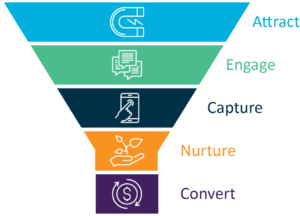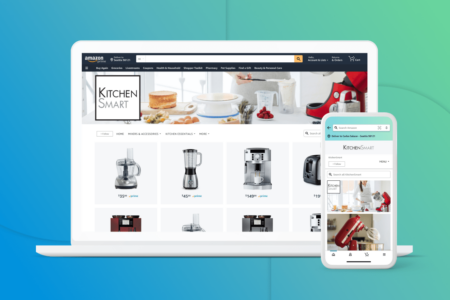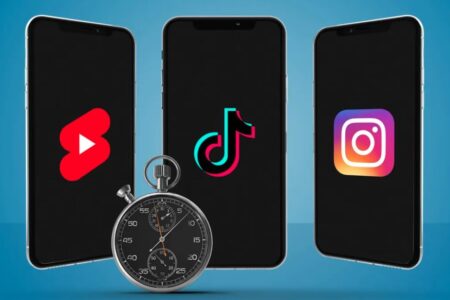 Marketing funnels are created to depict a customer’s journey from the initial brand awareness to ultimately, conversion. As such, an in-depth analysis of your funnel allows you to come up with strategies to target customers on each stage of the process – and a step by step plan can enhance sales, spread brand awareness and create a loyal customer base.
Marketing funnels are created to depict a customer’s journey from the initial brand awareness to ultimately, conversion. As such, an in-depth analysis of your funnel allows you to come up with strategies to target customers on each stage of the process – and a step by step plan can enhance sales, spread brand awareness and create a loyal customer base.
While the traditional funnel follows the popular AIDA approach (Attention, Interest, Desire and Action) it has evolved over time to include new concepts. The new and improved digital marketing funnel has four stages; attract, nurture, convert and delight which all play a role in the customers experience through the funnel, but considering the immense competition and changing consumer expectations, these are further divided into sub-steps for a comprehensive outlook of a buyer’s journey.
Let’s dive in and consider the before and post purchase stages of the modern digital marketing funnel:
Pre-Purchase Stages
Engagement
In this stage, potential customers are made aware of a brand’s existence and the products and services that they offer. This is the stage where businesses can engage customers by providing them with unique and valuable information through various channels such as; social media posts, positive reviews on the website, etc. Most importantly, remember to serve up the right content at the right time to your buyers to ensure that they are seeing some valuable insights prior to even engaging with your business.
Education
This stage is about identifying a problem faced by your target market and presenting your product or service as a good solution for it. This crosses over nicely with the engagement section as you initially make your brand’s existence aware to customers and then once they identify that you exist, you can then educate them on why your product or service is useful for them and something they’d invest in.
The other important factor about the education stage is that there is no hard selling as this is still part of the discovery phase and the last thing you want to do is push your audience offside by having a salesy element to your content.
Research
The discovery procedure continues with people seeking ways to solve their problem and they compare different providers to find out unique offerings. Their research is based on published content and aims to narrow down to a specific product or service.
This phase is particularly important as the information the end user is seeking is no longer generic and is more targeted to what solution they actually require, so the communication here needs to be spot on to ensure you don’t confuse your customers.
Evaluation
This stage of the funnel aims to direct the attention of your leads to a solution. Hence, your aim should to be highlight how your offering is different from your competitors. This can be done by showcasing the unique aspects of your product or service and the benefits derived from it.
It is also important to note that at this point, your potential customers will be looking at direct competitors for your service/product and it is important to do competitor analysis frequently to improve your content and provide a better representation of your offering.
Justification
This stage reinforces the prior claims made by marketers to leverage their products or services. There are times when customers may be sold on the product or service’s superiority claims, but they are not completely on board.
Through valid justifications, marketers can provide additional reasons to customers for choosing their solution. For example, if someone is interested in your service or product and they are offered something additional that they weren’t expecting that improves their experience with your offering, this might be enough to convert them into a customer.
Purchase
At this stage, marketers have the vital role of addressing potential concerns about the product to clarify any doubts and strengthen the brand’s image. By doing this effectively, you are able to lock in a purchase from the end user and move them into the post-purchase stages of the funnel.
Post-Purchase Stages
Adoption
The adoption stage refers mostly to the on-boarding process of your customer after they have invested in your product/service. After-sales service is critical for augmenting a brand’s image and creating a loyal customer base.
A rocky start to this stage means that all the trust you have built in the initial stages of your funnel might be for nothing, so being on top of what is your customer needs and delivering that is of utmost importance here.
Retention
Enticing leads to buy from you is a huge achievement, but marketers aim to retain these buyers by strengthening communication through various mediums. This is done by keeping track of consumers and ensuring that they have a positive experience with your product and service.
In turn, this allows you to promote authenticity in your brand and promotes a positive image to your customers, which can produce brand loyalty and advocacy down the track.
Expansion
If a product or service meets all the customer’s expectations and a strong post-purchase process is in place, customers will more than likely become repeat buyers. Marketers should then target these customers to up-sell high-end products and cross-sell complementary products.
Valuable add-on’s, upgrades or additional services are just some examples of what you could offer an audience that already trusts your core offering and might deliver further value than they first expected when engaging with your business.
Advocacy
A satisfied customer who feels that a brand stands by its promises pre and past purchase may end up becoming an advocate. Simply put, they spread your brand message and their positive experience through word of mouth, online reviews, forums, etc.
This serves to not only enhance your brand reputation, but also has a positive impact on your bottom line, which is what all businesses are trying to consolidate. Customers who are now advocating your business should receive the VIP treatment in whatever way you can and be encouraged to continually spread the word about your product or service for years to come.
Conclusion
Adopting the modern marketing funnel is vital for a business’s success as it puts all the concerns and shortcomings of the traditional funnel to rest. The AIDA model accounts for a customer’s journey from a macro standpoint, whereas the contemporary funnel has a micro approach and looks at each step of a customer’s life cycle.
Additionally, the contemporary digital marketing funnel makes room for post-purchase services that lead to customer retention and brand advocacy which in turn, can improve the way in which you nurture leads going forward.



